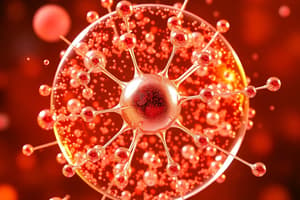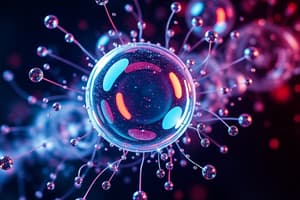Podcast
Questions and Answers
What is the fundamental characteristic of matter that is observed in everything around us?
What is the fundamental characteristic of matter that is observed in everything around us?
- It has neither mass nor volume
- It has only volume
- It has both mass and volume (correct)
- It has only mass
What did ancient Indian philosophers believe that everything was made up of?
What did ancient Indian philosophers believe that everything was made up of?
- The five basic elements - Panch Tatva (correct)
- Four basic elements
- Six basic elements
- Ten basic elements
What is the classification of matter based on, according to modern day scientists?
What is the classification of matter based on, according to modern day scientists?
- Neither physical properties nor chemical nature
- Only physical properties
- Only chemical nature
- Both physical properties and chemical nature (correct)
What was the difference in the two schools of thought regarding the nature of matter?
What was the difference in the two schools of thought regarding the nature of matter?
What will be discussed in subsequent chapters?
What will be discussed in subsequent chapters?
What is the term used to describe the amount of space occupied by an object?
What is the term used to describe the amount of space occupied by an object?
What is the primary reason why a sponge can be compressed?
What is the primary reason why a sponge can be compressed?
Which of the following is NOT a characteristic of the particles of a solid?
Which of the following is NOT a characteristic of the particles of a solid?
What is the primary reason why we can smell hot sizzling food from a distance, but not cold food?
What is the primary reason why we can smell hot sizzling food from a distance, but not cold food?
What is the common characteristic of a chair, almonds, and lemon water?
What is the common characteristic of a chair, almonds, and lemon water?
Which property of matter does a diver's ability to cut through water in a swimming pool demonstrate?
Which property of matter does a diver's ability to cut through water in a swimming pool demonstrate?
What is the shape of a sugar or salt crystal?
What is the shape of a sugar or salt crystal?
What happens to the salt/sugar particles when it dissolves in water?
What happens to the salt/sugar particles when it dissolves in water?
What is the SI unit of mass?
What is the SI unit of mass?
What is the purpose of Activity 1.2?
What is the purpose of Activity 1.2?
What is observed when potassium permanganate crystals are dissolved in water?
What is observed when potassium permanganate crystals are dissolved in water?
What is the purpose of Activity 1.3?
What is the purpose of Activity 1.3?
What is the relationship between 1L and 1 dm3 in terms of volume?
What is the relationship between 1L and 1 dm3 in terms of volume?
Flashcards are hidden until you start studying



